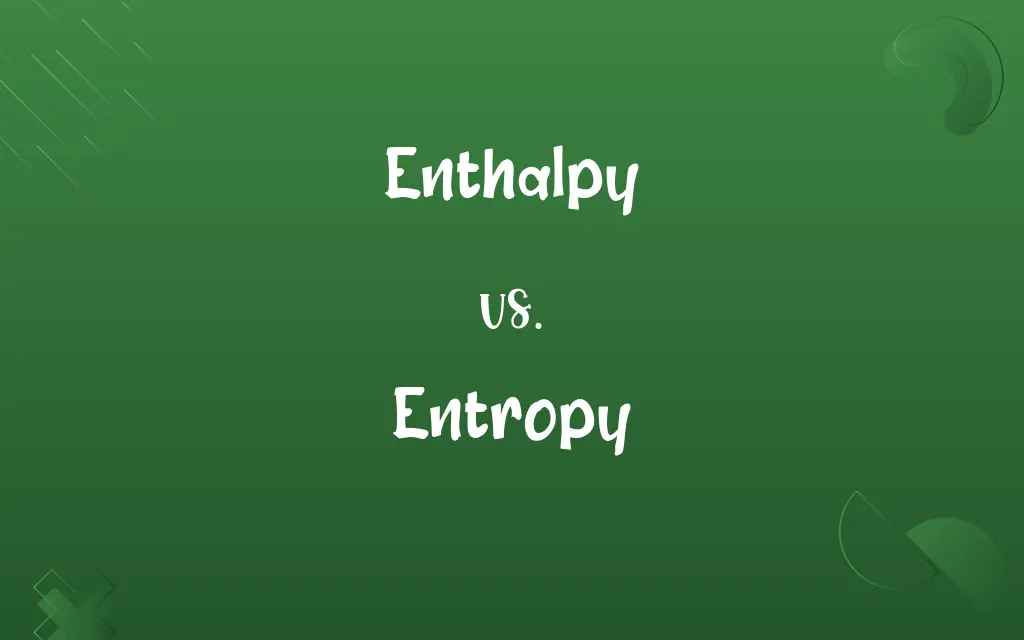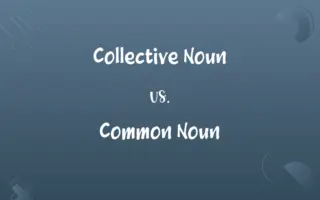Enthalpy vs. Entropy: Know the Difference

By Shumaila Saeed || Published on February 1, 2024
Enthalpy is the total heat content of a system, reflecting energy transfer in processes at constant pressure, while entropy measures disorder, indicating the number of ways a system can be arranged.

Key Differences
Enthalpy, a concept in thermodynamics, represents the total heat content of a system, integrating internal energy with the product of pressure and volume. In contrast, Entropy is a measure of disorder or randomness in a system. Both concepts are fundamental in understanding how energy and matter interact in physical and chemical processes.
Shumaila Saeed
Feb 01, 2024
Enthalpy changes indicate the amount of heat absorbed or released during a chemical reaction at constant pressure, serving as a crucial parameter in chemical thermodynamics. Entropy, on the other hand, quantifies the unavailability of a system's energy for doing work and the degree of disorder, playing a key role in predicting the spontaneity of processes.
Shumaila Saeed
Feb 01, 2024
In phase transitions, the enthalpy change reflects the energy needed for the transformation, such as melting or boiling. Simultaneously, the entropy change describes how the orderliness of the system varies during these transitions, with increased disorder during melting or vaporization.
Shumaila Saeed
Feb 01, 2024
Enthalpy is particularly useful in designing and analyzing heating and cooling systems, where energy transfer is vital. Entropy is fundamental in information theory and statistical mechanics, extending beyond physical sciences to quantify information and predict probabilities.
Shumaila Saeed
Feb 01, 2024
The concept of enthalpy is central to the understanding of energy conservation and efficiency in chemical reactions and processes. Entropy, by quantifying disorder, helps in understanding the direction of natural processes and the inherent tendency towards disorder in the universe.
Shumaila Saeed
Feb 01, 2024
ADVERTISEMENT
Comparison Chart
Physical Significance
Reflects energy transfer at constant pressure
Indicates unavailability of energy for work
Shumaila Saeed
Feb 01, 2024
Role in Reactions
Indicates heat absorbed or released
Measures spontaneity and direction of reactions
Shumaila Saeed
Feb 01, 2024
Application in Science
Central in chemical thermodynamics
Important in information theory, statistical mechanics
Shumaila Saeed
Feb 01, 2024
Change in Phase Transitions
Represents energy required for transformations
Describes change in orderliness during transitions
Shumaila Saeed
Feb 01, 2024
ADVERTISEMENT
Enthalpy and Entropy Definitions
Enthalpy
Enthalpy quantifies the total heat transfer in processes occurring at constant pressure.
In an isobaric process, the change in enthalpy equals the heat absorbed or released.
Shumaila Saeed
Jan 25, 2024
Entropy
Entropy is a thermodynamic quantity representing the unavailability of a system's energy for conversion into work.
An increase in entropy signifies greater disorder and energy dispersion in a system.
Shumaila Saeed
Jan 25, 2024
Enthalpy
Enthalpy is the total energy of a thermodynamic system, including internal energy and pressure-volume work.
The enthalpy change during a reaction helps predict whether it will be exothermic or endothermic.
Shumaila Saeed
Jan 25, 2024
Entropy
Entropy is a key factor in determining the direction and spontaneity of chemical and physical processes.
The second law of thermodynamics states that the entropy of an isolated system always increases.
Shumaila Saeed
Jan 25, 2024
Enthalpy
Enthalpy is a state function representing the sum of a system's internal energy and the product of its pressure and volume.
Calculating the enthalpy of combustion provides insights into the energy released by fuels.
Shumaila Saeed
Jan 25, 2024
ADVERTISEMENT
Entropy
Entropy is used to quantify the loss of energy for doing work and the spread of energy at a specific temperature.
In a closed system, entropy increases over time, leading to energy equilibrium.
Shumaila Saeed
Jan 25, 2024
Enthalpy
Enthalpy is a measure of the total heat and work potential of a thermodynamic system.
The enthalpy of vaporization is key in understanding the energy required to convert liquid to gas.
Shumaila Saeed
Jan 25, 2024
Entropy
Entropy measures the degree of randomness or disorder within a system.
Melting ice illustrates an increase in entropy due to increased molecular disorder.
Shumaila Saeed
Jan 25, 2024
Enthalpy
Enthalpy is the heat content of a system at constant pressure.
Enthalpy changes in a chemical process determine the heat exchange with the surroundings.
Shumaila Saeed
Jan 25, 2024
Entropy
Entropy is a state function that quantifies the number of microstates corresponding to a macrostate.
Higher entropy in gases compared to liquids indicates more molecular randomness.
Shumaila Saeed
Jan 25, 2024
Enthalpy
Symbol H A thermodynamic function of a system, equivalent to the sum of the internal energy of the system plus the product of its volume multiplied by the pressure exerted on it by its surroundings.
Shumaila Saeed
Jan 22, 2024
Entropy
Symbol S For a closed thermodynamic system, a quantitative measure of the amount of thermal energy not available to do work.
Shumaila Saeed
Jan 22, 2024
Enthalpy
A measure of the heat content of a chemical or physical system.
, where H is enthalpy, U is internal energy, p is pressure, and V is volume.
Shumaila Saeed
Jan 22, 2024
Enthalpy
(thermodynamics) a thermodynamic quantity equal to the internal energy of a system plus the product of its volume and pressure;
Enthalpy is the amount of energy in a system capable of doing mechanical work
Shumaila Saeed
Jan 22, 2024
Entropy
The tendency for all matter and energy in the universe to evolve toward a state of inert uniformity.
Shumaila Saeed
Jan 22, 2024
Entropy
The deterioration of a system or society, especially when it seems inevitable
City activists who fought entropy by organizing neighborhood groups.
Shumaila Saeed
Jan 22, 2024
Entropy
(Boltzmann definition) A measure of the disorder directly proportional to the natural logarithm of the number of microstates yielding an equivalent thermodynamic macrostate.
Shumaila Saeed
Jan 22, 2024
Entropy
A measure of the amount of energy in a physical system that cannot be used to do work.
Shumaila Saeed
Jan 22, 2024
Entropy
The capacity factor for thermal energy that is hidden with respect to temperature.
Shumaila Saeed
Jan 22, 2024
Entropy
The dispersal of energy; how much energy is spread out in a process, or how widely spread out it becomes, at a specific temperature.
Shumaila Saeed
Jan 22, 2024
Entropy
A measure of the amount of information and noise present in a signal.
Shumaila Saeed
Jan 22, 2024
Entropy
(uncountable) The tendency of a system that is left to itself to descend into chaos.
Shumaila Saeed
Jan 22, 2024
Entropy
A certain property of a body, expressed as a measurable quantity, such that when there is no communication of heat the quantity remains constant, but when heat enters or leaves the body the quantity increases or diminishes. If a small amount, h, of heat enters the body when its temperature is t in the thermodynamic scale the entropy of the body is increased by h ÷ t. The entropy is regarded as measured from some standard temperature and pressure. Sometimes called the thermodynamic function.
The entropy of the universe tends towards a maximum.
Shumaila Saeed
Jan 22, 2024
Entropy
(communication theory) a numerical measure of the uncertainty of an outcome;
The signal contained thousands of bits of information
Shumaila Saeed
Jan 22, 2024
Entropy
(thermodynamics) a thermodynamic quantity representing the amount of energy in a system that is no longer available for doing mechanical work;
Entropy increases as matter and energy in the universe degrade to an ultimate state of inert uniformity
Shumaila Saeed
Jan 22, 2024
Repeatedly Asked Queries
What does a change in enthalpy indicate?
A change in enthalpy indicates the amount of heat absorbed or released by a system at constant pressure.
Shumaila Saeed
Feb 01, 2024
What is the significance of entropy in the universe?
Entropy is key to understanding the direction and evolution of natural processes in the universe.
Shumaila Saeed
Feb 01, 2024
How is entropy related to disorder?
Entropy measures the degree of disorder or randomness in a system, with higher entropy indicating greater disorder.
Shumaila Saeed
Feb 01, 2024
Can enthalpy be negative?
Yes, enthalpy can be negative when a system releases more energy than it absorbs, typical in exothermic reactions.
Shumaila Saeed
Feb 01, 2024
Is entropy always increasing?
In an isolated system, entropy tends to increase, in accordance with the second law of thermodynamics.
Shumaila Saeed
Feb 01, 2024
What is enthalpy?
Enthalpy is the total heat content of a system, accounting for internal energy and the energy required for the system to expand or contract.
Shumaila Saeed
Feb 01, 2024
What role does enthalpy play in phase changes?
Enthalpy changes reflect the energy required for phase changes like melting or boiling.
Shumaila Saeed
Feb 01, 2024
Can entropy be reversed?
In a closed system, entropy tends to increase, making reversal challenging without external energy input.
Shumaila Saeed
Feb 01, 2024
What is the enthalpy of formation?
The enthalpy of formation is the heat change when one mole of a compound is formed from its elements.
Shumaila Saeed
Feb 01, 2024
What is the third law of thermodynamics about entropy?
The third law states that the entropy of a perfect crystal at absolute zero is exactly zero.
Shumaila Saeed
Feb 01, 2024
How does entropy affect the feasibility of a chemical reaction?
Greater entropy often makes a reaction more spontaneous, as the universe tends towards higher entropy.
Shumaila Saeed
Feb 01, 2024
How does entropy relate to temperature?
Generally, entropy increases with temperature, as higher temperatures correspond to greater molecular motion and disorder.
Shumaila Saeed
Feb 01, 2024
How does enthalpy relate to bond energies?
Enthalpy changes in reactions are related to the breaking and forming of chemical bonds, with energy absorbed or released.
Shumaila Saeed
Feb 01, 2024
Does entropy change in an isothermal expansion?
Yes, in an isothermal expansion, entropy increases as the system's volume increases, allowing more molecular arrangements.
Shumaila Saeed
Feb 01, 2024
How is enthalpy measured?
Enthalpy is typically measured in joules or calories, reflecting the energy content of a system.
Shumaila Saeed
Feb 01, 2024
What influences enthalpy in a chemical reaction?
Enthalpy in a reaction is influenced by the nature of reactants and products, temperature, and pressure.
Shumaila Saeed
Feb 01, 2024
Can enthalpy be directly observed?
Enthalpy cannot be directly observed; it's calculated based on temperature, pressure, and state changes.
Shumaila Saeed
Feb 01, 2024
What is standard enthalpy change?
Standard enthalpy change refers to the enthalpy change when reactants and products are in their standard states.
Shumaila Saeed
Feb 01, 2024
Is a high entropy state more stable?
Often, yes. Higher entropy states are typically more stable due to increased disorder and energy distribution.
Shumaila Saeed
Feb 01, 2024
Does entropy have units?
Yes, entropy is measured in units of joules per kelvin (J/K).
Shumaila Saeed
Feb 01, 2024
Share this page
Link for your blog / website
HTML
Link to share via messenger
About Author
Written by
Shumaila SaeedShumaila Saeed, an expert content creator with 6 years of experience, specializes in distilling complex topics into easily digestible comparisons, shining a light on the nuances that both inform and educate readers with clarity and accuracy.






































































